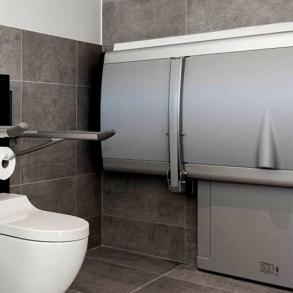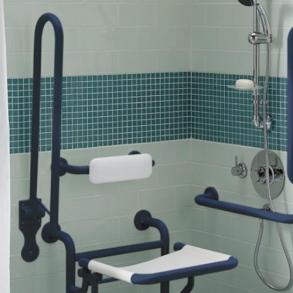1. Rimless Toilets
Rimless toilets are perhaps the most hygienic toilet pan options available. They reduce the spread of harmful bacteria, use less water than conventional toilets, and improve the easy-clean nature of your washroom. Items like the Armitage Shanks Contour 21+ Back To Wall Toilet use as little as 3 litres for a complete and powerful flush and also comply to disabled raised height dimensions at the same time. Thought should also be given to anti-vandal toilets which cannot be broken and leave sharp edges where a user could harm themselves. This is particularly important in institutional facilities such as prisons, hospitals and sites involved with mental health. 
2. Emergency Pull Cords
You’ve all seen them, and if you’re the caretaker of a facility in the healthcare sector you’ll know just how important they are. However, as simple as they are to install, it’s worth scheduling this at the correct time in the refurb to ensure you get to cleanest, smartest finish in the washroom.
3. Antibacterial Gel Dispensers
Dispensers of antibacterial gel have become one of the most common sights in the healthcare sector, with the sales and distribution of sanitising gel rising exponentially over the past decade. However, not all dispensers are designed to be used by those with limited dexterity. Items like our Brushed Stainless 400ml Sanitiser Spray Dispenser are designed for complete ease of use and can be activated by elbow or closed fist.
4. Safety Flooring
Spills are more common in the healthcare environment than anywhere else making safety flooring is an absolute essential. Anti-slip safety flooring goes down in much the same way as lino, but is more durable and carries more pronounced anti-slip properties. It also laps up the edges of the room much like skirting board and means the room can be deep cleaned much more easily. You’ll often find that healthcare sector washrooms also have a floor drain in the washroom so that it can be hosed down.
5. Antibacterial Sanitised Grade Items
Duct panel systems used to conceal pipework behind toilets, wash basins, surgical scrubups and plaster sinks can be made to an antibacterial sanitised grade. The panels used for cladding are made from impact resistant, sanitised antibacterial grade laminate for optimum hygiene. This means you can also use cleaning chemicals on them without affecting the life of the material.
6. Water Safety Plans (WSPs)
Water Safety plans are a vital part of HTM 64, the guideline for healthcare sector washrooms. WSPs need to be put in place to keep a close eye on the water supply and should include temperature regulation and regular checks to prevent bacteria contamination to the water supply. A recorded schedule of Legionella and P. Aeruginosa checks will be needed in environments where HTM 64 is relevant as will the use of TMV3 thermostatic valves.
7. Wash Basins
Wash basins should be of minimalistic design and in most cases, comply with HTM 64. Vitreous china washbasins that are designed to a hospital pattern have their drainage outlet situated horizontally at the back of the basin. You’ll also note that basins in this environment have no holes for taps, overflows or chains, leaving you with a surface that is incredibly easy to sanitise.
8. Taps
Taps in the healthcare sector need to be horizontal and wall mounted. Users also need to be able to operate them by using a closed fist or elbow. This stops contamination and the spread of bacteria and is a reason why sensor taps have become the most popular option in the healthcare sector. The tap will also need to have an open nozzle and flow straightener. The flow of water cannot flow directly into the drain outlet, which the hospital pattern basin helps to prevent.
9. TMV3 Mixer Valves
Some sensor taps have this special valve integral to their design, however, if you are opting for other types of taps, then TMV3 D08 approved thermostatic mixer valves should be fitted on the hot water supply. This accurately controls the temperature of water and prevents scolding to the user.
10. Anti Ligature Fittings
Anti ligature items are designed so that they can’t be easily prised away from the wall, and can’t be used to hang anything from. This is a vital requirement in institutional facilities such as hospitals, prisons, and sites involved with mental health. Anti ligature items should be chosen wherever possible to reduce the risk of users harming themselves.
If you would like to discuss your healthcare sector washroom, or have any questions about the items and considerations outlined above, please get in touch on 01202 650900




